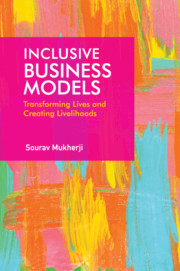Book contents
- Frontmatter
- Dedication
- Contents
- List of Tables
- List of Figures
- Preface
- Acknowledgements
- 1 Introduction
- 2 Vaatsalya Hospitals: Affordable Healthcare in Proximity
- 3 Gyan Shala: Providing Inclusive Education
- 4 Rang De: Creating a Platform for Social Investing
- 5 Labournet: Empowering Informal Sector Labourers
- 6 Selco: Inclusive Model for Energy Access
- 7 Hasiru Dala Innovations: Improving Lives of Waste Pickers
- 8 Reliance Retail: Creating Inclusive Supply Chain
- 9 International Development Enterprise (Ide) Nepal: Developing Smallholder Ecosystem
- 10 Ruralshores: Delivering Inclusive Service
- 11 Gujarat Narmada Fertilizer Company’s (Gnfc) Neem Initiative: A Social Business
- 12 Bringing it All Together
- References
- Index
6 - Selco: Inclusive Model for Energy Access
Published online by Cambridge University Press: 31 July 2021
- Frontmatter
- Dedication
- Contents
- List of Tables
- List of Figures
- Preface
- Acknowledgements
- 1 Introduction
- 2 Vaatsalya Hospitals: Affordable Healthcare in Proximity
- 3 Gyan Shala: Providing Inclusive Education
- 4 Rang De: Creating a Platform for Social Investing
- 5 Labournet: Empowering Informal Sector Labourers
- 6 Selco: Inclusive Model for Energy Access
- 7 Hasiru Dala Innovations: Improving Lives of Waste Pickers
- 8 Reliance Retail: Creating Inclusive Supply Chain
- 9 International Development Enterprise (Ide) Nepal: Developing Smallholder Ecosystem
- 10 Ruralshores: Delivering Inclusive Service
- 11 Gujarat Narmada Fertilizer Company’s (Gnfc) Neem Initiative: A Social Business
- 12 Bringing it All Together
- References
- Index
Summary
According to the Indian census in 2011, 81 million households in India suffered from energy poverty, of which 71 million were in rural India. Energy poverty is defined as households having less than adequate consumption of energy, using a polluting source of energy or spending excessive time in collecting fuel. While the Government of India took an aggressive target of connecting every Indian village to the grid and declared in April 2018 that, with the electrification of Leisang village in the state of Manipur, India has achieved 100 per cent rural electrification, connection to the grid did not imply that households in a village had access to electricity. A village was declared electrified if 10 per cent of the households could access electricity along with public institutions, such as health centres and schools. Hamlets and the residences of poor households were not considered in this calculation. Thus, even if a greater number of households might have obtained access to electricity post the 2011 census, a significant part of rural India and considerable part of urban India continue to have unreliable and intermittent access to electricity, if at all. Dr Harish Hande founded SELCO in 1995 to sell solar lights to the poor with a belief that access to solar energy would significantly improve the productivity of rural households. By 2010, SELCO had sold solar lights to more than 120,000 rural homes and 4,000 institutions, such as orphanages, clinics, seminaries and schools, in the state of Karnataka. Additionally, through its partnership with the Self-Employed Women's Association (SEWA), it had provided energy-efficient cook-stoves and solar lamps to another 80,000 poor consumers in the state of Gujarat. In this chapter, we look at how SELCO evolved as an organization, the various challenges it faced along the way and the unconventional ways by which it overcame them. We end the chapter by discussing what may be some of the lessons that social enterprises can learn from SELCO's journey.
THE EARLY DAYS
Harish got the idea of bringing solar lighting systems to rural India when he was doing his PhD on sustainable energy at the University of Massachusetts in the USA. During a field visit to the Dominican Republic, he was surprised to find poor villagers using solar lighting and reasoned that if it was possible there, he should be able to bring solar lights to the rural poor in India too.
- Type
- Chapter
- Information
- Inclusive Business ModelsTransforming Lives and Creating Livelihoods, pp. 128 - 159Publisher: Cambridge University PressPrint publication year: 2021



